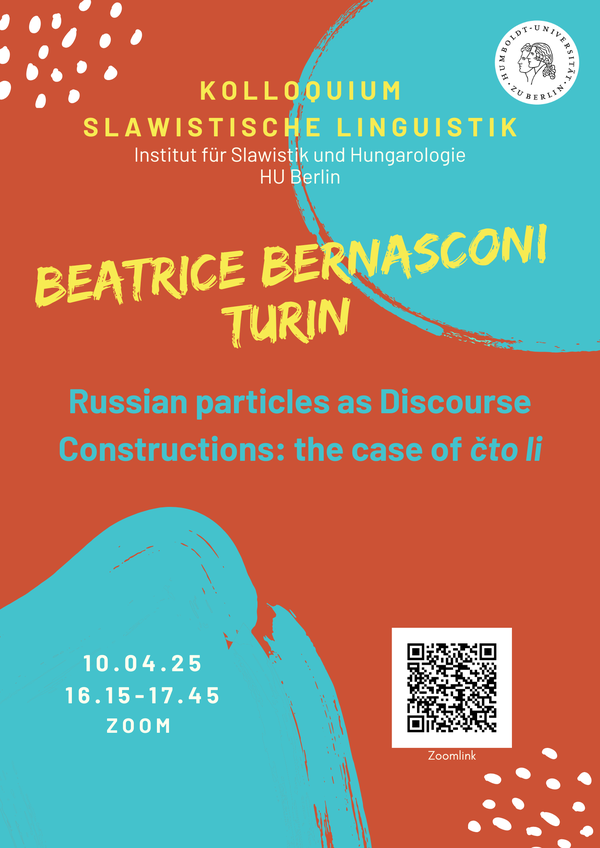Vortrag Beatrice Bernasconi (Kolloquium Slawistische Linguistik)
- https://www.slawistik.hu-berlin.de/de/veranstaltungen/slawling/bernasconi25
- Vortrag Beatrice Bernasconi (Kolloquium Slawistische Linguistik)
- 2025-04-10T16:15:00+02:00
- 2025-04-10T17:45:00+02:00
- Wann 10.04.2025 von 16:15 bis 17:45
- Wo zoom
- Name des Kontakts Berit Gehrke
- Web Externe Webseite besuchen
-
iCal
10.04. Beatrice Bernasconi (Turin): Russian particles as discourse constructions: The case of čto li [zoom]
According to Construction Grammar (Goldberg 1995, 2006), the basic unit of a language is a construction, namely, a form-meaning pairing that is conventionalized and entrenched in the speakers’ mind. Within the constructionist community, however, what kind of linguistic and extra-linguistic information should be included in the description of a construction is still a matter of debate (Boas et al. 2024), and this discussion regards, among other issues, pragmatic and discourse information too (Östman 2005; Cappelle 2017; Leclercq 2020). Another relevant question constructionists often face regards the role and usefulness of a formalism within CxG (Boas et al. 2024).
Drawing from the work of Östman (2005), Fried & Östman (2005), and Fried (2009, 2021), I will address these two questions through a case-study that illustrates how the Russian particle čto li can be analysed in constructional terms taking into account its semantic, pragmatic, and discourse properties in spoken language. My analysis is based on the data of the Multimedia subcorpus of the Russian National Corpus and exploits both quantitative and qualitative methodologies. The results show that čto li is not only used in polar (often rethorical) questions, but also in declaratives to express uncertainty and in imperatives to express urgency. I motivate this polyfunctionality both semantically and pragmatically discussing the particle’s semantic encoding of “non-exclusion of factuality” (Pietrandrea 2007, 2012) and its behaviour as a modal particle (Diewald 2006; Fischer 2006; Fischer & Heide 2018). From the discoursive point of view, factors such as the relationship between participants and the discourse setting are considered to provide a thorough description of the čto li constructions, which are translated into Construction Grammar formalism (Fried & Östman 2004) to better highlight their overlaps.

